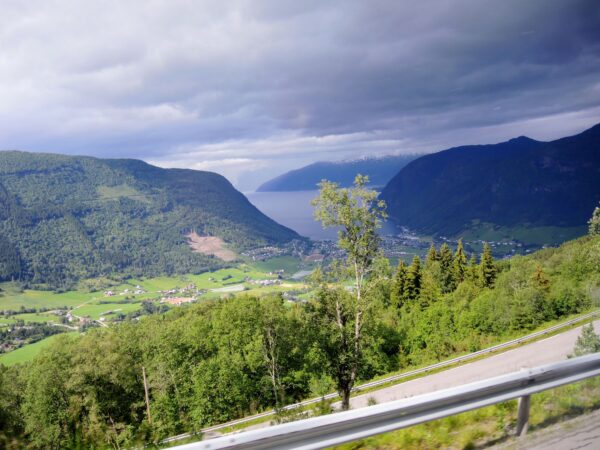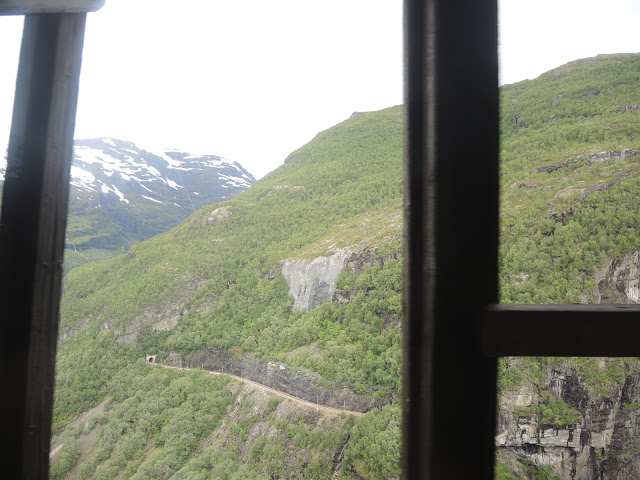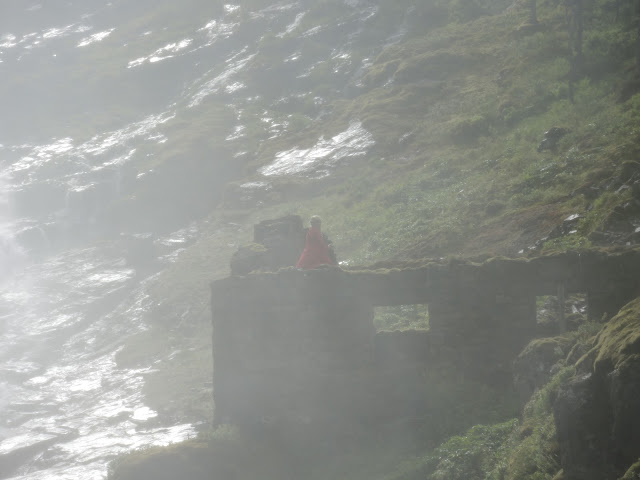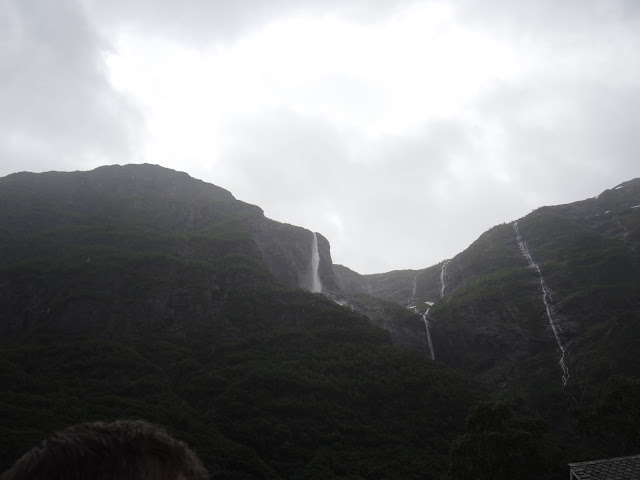There are occasions in my life when I believe I’m one of the smartest people in the room. More often than not, I’m reminded this isn’t usually the case. I commented to someone in an email recently that this trip had the feel of a “drive-by” tour of the sort depicted in the 1969 movie “If It’s Tuesday, This Must Be Belgium.” Because our time in the capital cities and cultural centers of these relatively small countries has been so limited, I had the sense that I was missing sites and attractions I should see. And objectively, that is so.
However, this morning, I happened to look at one of the travel documents distributed by Frederick, our well-informed guide whose sense of humor and his temper sometimes evoke memories of my father and realized it’s my perspective and expectations that need to change. The tour I’m on is called Scandinavian Panorama. Well, a definition of panorama is, “an unobstructed and wide view of an extensive area in all directions.” It can also be, “a continuously passing or changing scene.” Thus, the tour is exactly what it purported itself to be.
On this trip, there are days when the primary activity is moving through the epic scenery of southern Norway by one means of transportation or another. Today is one of those days. By day’s end, we will have ridden a bus from Bergen to Voss, a train from Voss to Myrdal, another train from Myrdal to Flåm, ridden on a ferry through parts of the Aurlandsfjord and the Sognefjord, gotten back on the bus for a ride along the Sognefjord before ending with another (short) ferry ride across the fjord where we stay on the bus finishing with a short ride to the hotel in Balestrand. So, perhaps in addition to enjoying the scenery,

this is a good time to write a bit about Norway – its history, folklore, geography and perhaps its political system.
Norway is the only Scandinavian country and one of two Nordic countries that are not full members of the European Union. (Iceland is the other.) While we in the States tend to think of Nordic and Scandinavian as interchangeable, the people themselves do not. Danes, Norwegians and Swedes will quickly tell you (and I am given to believe so will Finns) that Finland is a Nordic country but is not part of Scandinavia.
Culturally, militarily, and politically, much of northern Europe has been dominated by one of the three traditional Scandinavian monarchies. Finland was dominated for eight centuries by either Sweden or Russia and only became an independent country in 1917.
Still, it’s confusing. Geographically, the Scandinavian Peninsula consists of Norway, Sweden, and a small part of northern Finland. Linguistically, Finnish is considered a Uralic language and unrelated to the Indo-European Germanic of the three Scandinavian countries. Danish, Norwegian, and Swedish appear more like closely related dialects of a single language rather than being three unique languages. In a nutshell, if you travel here, limit your use of Scandinavian to refer to the three countries of Denmark, Norway, and Sweden and use Nordic to include Finland, Iceland, Greenland, and the Faroe Islands. Everyone will be happy with that.
Now let’s get on the train. Our first stop was the town of Voss. This was a brief stop mainly to transfer to the train to Myrdal. However, I managed to hurriedly snap this photo
which is a memorial to someone born in Voss who is familiar to many Americans – Knute Rockne (pronounced K-noot Rawk-neh).
From Voss, we boarded a train to Myrdal for our ride on the famous Flåm Railway. Although the line was originally built as part of the Norwegian National Rail System to connect the main Bergen Line with Sognefjord and, while it might be used by some for that purpose, it’s now mainly a Norwegian tourist attraction.
Although only 20 kilometers long, it needed 16 years (1924 – 1940) to complete because it’s the steepest standard gauge railway in Europe. Its breathtaking course takes it through an 863-meter change in elevation. Our ride from Myrdal started at 865 meters elevation and passed downhill to Flåm at two meters above sea level.
While the train passes through 20 tunnels, it crosses only one bridge and you can see the support slats in the photo below.
It’s a bit difficult to capture on camera one of the truly spectacular aspects of this journey – the dramatic cliffs and drop-offs but I hope this image gives a sense of that.
One of the amusing aspects of the journey arises from the fact that this line is now operated mainly as a tourist ride. Thus, from time to time, a recorded announcement will begin, “Ladies and gentlemen, if you look out the left side of the train…” You can see what transpires in one of the photos in my Bergen to Balestrand photo album.
Much of Nordic folklore has references to a siren like creature that the Norwegians call a hulder (HOOL-dur). One of the legends associated with this mythical creature, who hides her cow’s tail from her human victim, is that she appears out of the mist enticing men with a mixture of dance and song and a physical beauty that men can’t resist. She then lures them into caves from which they can never escape.
When the Flåm Railway makes its stop at Kjos Falls, the (Kjosfossen) tourists get a little show in the form of projected music and one or two students from the Norwegian Ballet School who appear in the mist and dance. Between the spray from the Falls and the glare of the sun on my viewer, I was barely able to capture one of them but look for her in red near the center of the picture dancing her dance of invitation on the remains of an old power station.
Here’s a shot of the falls. They have a total drop of 225 meters and
there’s a small power station that generates some of the power to run the rail line. Now for a fun fact about Norway: Virtually all of the country’s power is generated hydroelectrically so the nation is essentially running on 100 percent renewable sources. For this, they earn a bravo.
Of course, they are also major exporters of oil and natural gas. In fact, Norway is the second or third largest exporter of natural gas in the world and supplies a bit more than 20 percent of the natural gas used by the rest of Europe. The country is also among the top ten in exports of oil as well. They use much of the revenue from this to support the extensive network of social welfare programs known as Scandinavian socialism, Nordic social democracy, or sometimes Nordic capitalism. I’ll share more on that in a later post.
The town of Flåm (pronounced FLo-um) is a charming little village sitting on the fjord in a valley surrounded by mountains. The Aurlandsfjord cruise took us to Udvangen where, as we disembarked, we saw this triple waterfall:.
Those who have cruised the Alaskan fjords have likely seen waterfalls like this. They are equally ubiquitous throughout the Norwegian fjord system. It’s possible we saw more of them than some others might see on a trip in a different year because the spring and summer of 2015 have been unusually wet and cool thus increasing the water levels while slowing some melting that might typically occur earlier in the year.
We ended our day in Balestrand where we would have a bit of a breather spending one full day and two nights in the picturesque little village. My hope and plan was to rest and catch up on some writing but as you will learn, I was foiled by both nature and technology.





I cannot help but wonder what this country area is like in winter. And how people initially (pre-historically) settled it. It seems both beautiful and harsh. Lush but intimidating in a way (tall mountains, steep drops). I sense from your posts that you are feeling a bit more rushed on the tour than you would like (Belgium reference a strong clue). Cheers, C
Well, another thing to consider about living in these latitudes is that while I was there I experienced 18+ hours of daylight which means conversely in the winter season the daylight is 6 hours or less.
As for the “Belgium” reference, once I adjusted my attitude and expectation, I had a similar adjustment to my perception and experience.